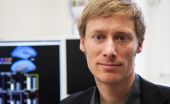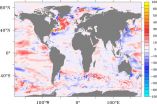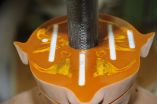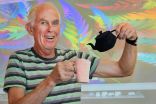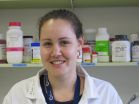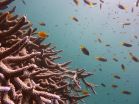Toward a low-cost 'artificial leaf' that produces clean hydrogen fuel
2014-12-03
(Press-News.org) For years, scientists have been pursuing "artificial leaf" technology, a green approach to making hydrogen fuel that copies plants' ability to convert sunlight into a form of energy they can use. Now, one team reports progress toward a stand-alone system that lends itself to large-scale, low-cost production. They describe their nanowire mesh design in the journal ACS Nano.
Peidong Yang, Bin Liu and colleagues note that harnessing sunlight to split water and harvest hydrogen is one of the most intriguing ways to achieve clean energy. Automakers have started introducing hydrogen fuel cell vehicles, which only emit water when driven. But making hydrogen, which mostly comes from natural gas, requires electricity from conventional carbon dioxide-emitting power plants. Producing hydrogen at low cost from water using the clean energy from the sun would make this form of energy, which could also power homes and businesses, far more environmentally friendly. Building on a decade of work in this area, Yang's team has taken one more step toward this goal.
The researchers took a page from the paper industry, using one of its processes to make a flat mesh out of light-absorbing semiconductor nanowires that, when immersed in water and exposed to sunlight, produces hydrogen gas. The scientists say that the technique could allow their technology to be scaled up at low cost. Although boosting efficiency remains a challenge, their approach -- unlike other artificial leaf systems -- is free-standing and doesn't require any additional wires or other external devices that would add to the environmental footprint.
INFORMATION:
The authors acknowledge funding from the U.S. Department of Energy and the Singapore-Berkeley Research Initiative for Sustainable Energy.
The American Chemical Society is a nonprofit organization chartered by the U.S. Congress. With more than 161,000 members, ACS is the world's largest scientific society and a global leader in providing access to chemistry-related research through its multiple databases, peer-reviewed journals and scientific conferences. Its main offices are in Washington, D.C., and Columbus, Ohio.
To automatically receive news releases from the American Chemical Society, contact newsroom@acs.org.
Follow us: Twitter Facebook
ELSE PRESS RELEASES FROM THIS DATE:
2014-12-03
Their novel findings obtained by measuring "cortical thickness" for the first time in the eating disorder are now published in the renowned journal "Biological Psychiatry". The authors conclude, "The global thinning of cortical gray matter observed in acutely ill adolescent patients can be completely reversed following successful weight rehabilitation therapy". Previous studies of changes in brain structure associated with anorexia nervosa were limited in their ability to clarify important questions regarding the regional specificity and persistence of anomalies following ...
2014-12-03
The Ebola epidemic in West Africa has pushed the decades-long search for a treatment to a frenetic pace. Somewhere in the virus' deceptively simple structure is a key to taming it. To find that key, scientists are undertaking multiple strategies, some of which are being fast-tracked for human testing, according to an article in Chemical & Engineering News (C&EN), the weekly newsmagazine of the American Chemical Society.
Senior editors Lisa M. Jarvis and Bethany Halford of C&EN note that the Ebola virus is endowed with a mere seven genes that code for eight proteins. Although ...
2014-12-03
New research shows that ocean heat uptake across three oceans is the likely cause of the 'warming hiatus' - the current decade-long slowdown in global surface warming.
Using data from a range of state-of-the-art ocean and atmosphere models, the research shows that the increased oceanic heat drawdown in the equatorial Pacific, North Atlantic and Southern Ocean basins has played a significant role in the hiatus.
The new analysis has been published in Geophysical Research Letters by Professor Sybren Drijfhout from the University of Southampton and collaborators from ...
2014-12-03
This news release is available in German.
The new study establishes that the best combination for incentives and punishment that promotes cooperation are in the form of "First carrot, then stick". The mathematical proof shows how the combined sequential use of reward ("carrot") and punishment ("stick") promotes cooperation in collaborative endeavors, such as protecting social commons and maintaining mutual aid.
Rewards and punishments are the most tried and true approaches when trying to promote cooperation in collaborative endeavors. New research, in terms of ...
2014-12-03
Analysis of data from the MATROSHKA experiment, the first comprehensive measurements of long-term exposure of astronauts to cosmic radiation, has now been completed. This experiment, carried out on board and outside of the International Space Station, showed that the cosmos may be less hostile to space travellers than expected.
Among the many life-threatening hazards to the space traveller, cosmic radiation is a major one, considerably limiting the time astronauts may spend in space without incurring excessive risk to their health from too high a dose of this ionizing ...
2014-12-03
An Australian National University (ANU) mathematician has developed a new way to uncover simple patterns that might underlie apparently complex systems, such as clouds, cracks in materials or the movement of the stockmarket.
The method, named fractal Fourier analysis, is based on new branch of mathematics called fractal geometry.
The method could help scientists better understand the complicated signals that the body gives out, such as nerve impulses or brain waves.
"It opens up a whole new way of analysing signals," said Professor Michael Barnsley, who presented ...
2014-12-03
INDIANAPOLIS, December 2, 2014 -- Today, Eli Lilly and Company announced results from new analyses of two Phase 3 trials evaluating the relationship between cognitive and functional treatment effects in patients with mild Alzheimer's disease. Based on post-hoc analyses of the Phase 3 trials, the findings suggested that cognitive deficits were more apparent than functional deficits in mild Alzheimer's disease when measured with the Alzheimer's disease Assessment Scale-Cognitive (ADAS-Cog) and the Alzheimer's disease Cooperative Study-Activities of Daily Living (ADCS-ADL) ...
2014-12-03
Amsterdam, The Netherlands, December 2, 2014 - Detection, prevention, and preclinical treatment are three key areas that may make a difference in the battle to reduce the rapid rise of new Alzheimer's disease (AD) cases every year. These three topics are the focus of an important new supplement to the Journal of Alzheimer's Disease.
Organized by Guest Editor Jack de la Torre, MD, PhD, Professor of Neuropsychology at The University of Texas at Austin, the supplement is a novel guide to how Alzheimer dementia may be approached and managed right now, not years from now. ...
2014-12-03
Scientists have released details of a raft of new chemicals with potent anti-malarial properties which could open the way to new drugs to fight the disease.
A new paper in PNAS is the third published by the group at the Australian National University (ANU), which has collaborated with groups from around the globe to uncover potential ammunition in the fight against malaria.
Over 200 million people contract malaria each year, and the parasite that causes the disease has become resistant to most of the drugs currently available.
"The papers show the malaria parasite ...
2014-12-03
A glimmer of hope for corals as baby reef builders cope with acidifying oceans
While the threat of coral bleaching as a result of climate change poses a serious risk to the future of coral reefs worldwide, new research has found that some baby corals may be able to cope with the negative effects of ocean acidification.
Ocean acidification, which is a direct consequence of increased atmospheric carbon dioxide levels, is expected to have a deleterious effect on many marine species over the next century.
An international team examining the impact of ocean acidification ...
LAST 30 PRESS RELEASES:
[Press-News.org] Toward a low-cost 'artificial leaf' that produces clean hydrogen fuel
